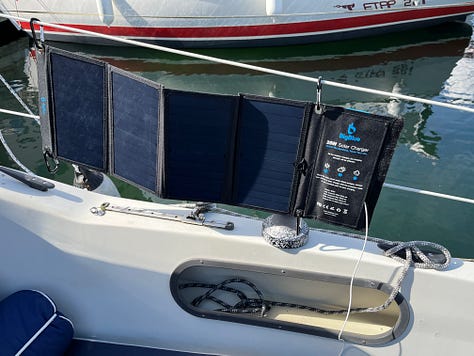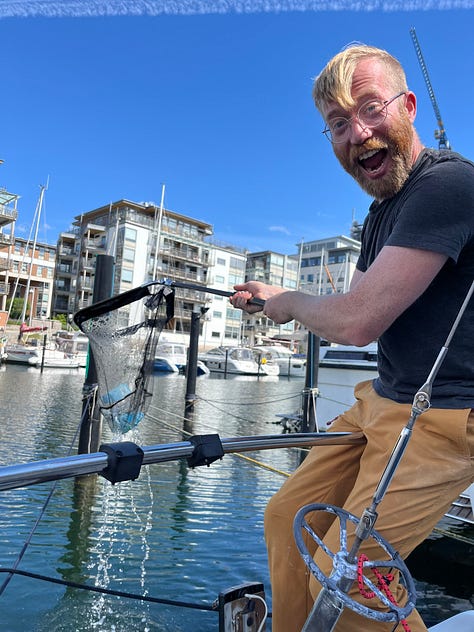Last time we took out our boat, the engine failed twice - once outside the harbor and once while in the harbor about to dock. We handled it well and were able to get it restarted quickly, but it was unnerving. So we decided to have an engine day where we try to figure out this mysterious and intimidating creature.
We started with figuring out what kind it is (Yamaha F5A 5 horsepower) and downloading the manual in English (the one we have on the boat is in Swedish, which works but breaks my brain extra when trying to figure out new things, plus Finnish Greek and Portuguese which don’t help us much!)
I read about 2/3 of the manual and learned many new and useful things such as:
We must use gas of at least 90 octane (max 10% ethanol)
The choke must be out to start “to provide the rich fuel mix needed to start the engine.” (Always wondered what that thing was doing?!). After starting the choke should be pushed halfway in for 5 mins during the “warmup period,” during which the throttle should not be over 20%. After 5 mins push choke all the way in, and can use full throttle. Bad to run motor with choke out. If starting a warm engine, choke can be in.
There’s a “cock” (tee hee)/lever that’s used to select fuel source from the motor itself (1L tank) or from the external 20L tank. It should be closed when you’re not using the motor to avoid leaks. (We didn’t know this existed and it’s been in the same position since we bought the boat until today!)
If running from the 1L tank on the engine, open the air vent 1-2 turns, remove the engine cover and pump the tiny hand pump until firm.
The cap at the top of both fuel tanks has a vent that’s separate from the closure itself, you can just crack the air vent (inner part) not loosen the whole thing!
Safety: You should check the stop button and the deadman switch with the engine running to make sure it stops.
Safety 2: And check that it’s impossible to start the engine with the deadman off.
Not in the manual but from messing around: to lift the engine in/out of the water (sliding along the metal track attached to the back of the boat), lift out the black pin and pull up on the pin itself (not the motor). It’s heavy and awkward and there’s no good way to do it, but works best from just above/to the port side.
To tilt the motor from perpendicular to angle it out of the water, approach from starboard. Pull out black pin and slide up/down.
Check dipstick for oil between markers. The window above is for seeing when it’s running not checking the level.
We followed the directions from the manual to start the motor first from the built in fuel tank, then switched to the external fuel tank we’ve always used. Both worked perfectly and sounded good. (So what was wrong last time?!? No idea.)
I wonder if we need to be more pedantic about the 5 min warmup period, perhaps let the engine run in neutral for that long before we motor out? And start the motor earlier when coming back in? In any case, we didn’t really do anything functional (had the idea of changing the oil filter but the one we bought was the wrong size, we have to special order it from Yamaha) so I think we’ll just cross fingers and hope all works as it should next time we’re out!


This video from FixItSam was also helpful to see the basic parts in action (fuel filter, spark plugs etc):
In non-engine related news:
Quite happy with our solar phone charger, it works great. And with the boxy scoop for emptying the water that gets in the cockpit facks, works much better than a cup.
Last time we were out we saw floating styrofoam and though Kalle made a valiant attempt we had nothing to fish it out of the sea. So we got a fishing net at Biltema and Simon was happy to put it to use to grab some harbor trash today.
And we had some time to chill on the boat, including the first hammock hang of 2024. :)







This post made me laugh... Clearly, you weren't doing your own engine maintenance as a kid :)
RTFM used to be my mantra when fam asked me questions about computer lol.
BTW, I have been told that those engines that have an integrated gas tank are pretty nice - probably will never need the auxillary external tank.